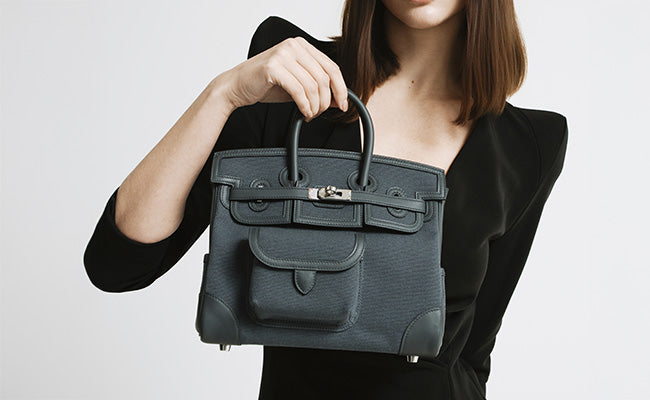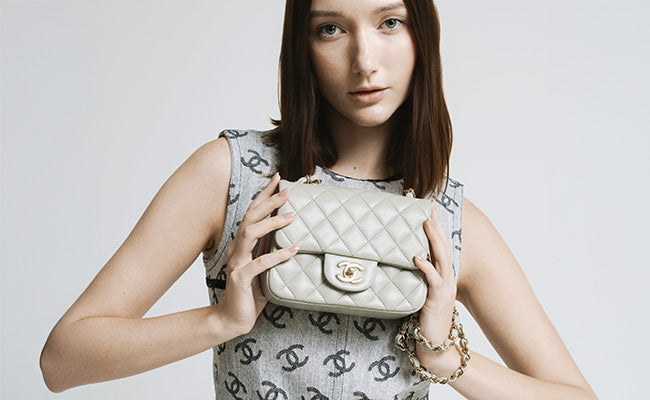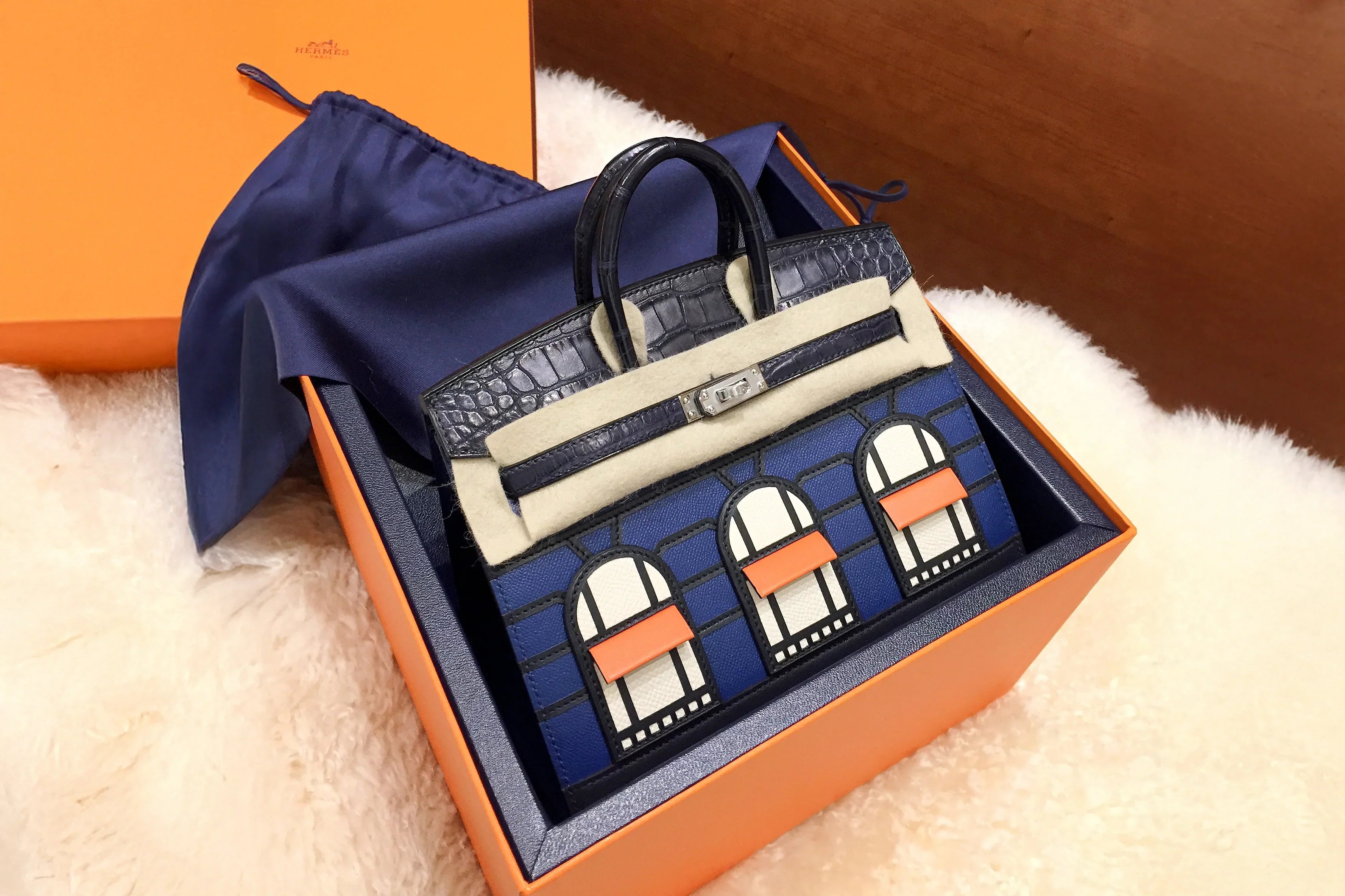
Touch Birkin & Touch Kelly: Mixed‑Material Masterpieces Explained
Check out our Hermès collection and Birkin bags!
When Hermès rolled out the Touch collection in 2017, they did something refreshingly different for luxury handbags: they blended everyday practicality with a dash of exotic luxury.
These aren’t your average Birkin or Kelly bags, but they’re not the kind of full on exotic pieces that make you nervous to actually use them, either.
Touch Birkins and Touch Kellys mix classic leathers like Togo or Clemence for the main body with crocodile or alligator accents on the flap, handles, and some hardware details.
This clever combo gives you the wow factor and status of exotic leather, but without the full on price or the “handle with gloves” anxiety of a completely exotic bag.
What makes these bags so tempting? They solve a real collector’s dilemma. You get that eye catching contrast and texture, but the leather body stays practical for daily wear. Hermès really nailed the balance here.
Key Takeaways
- Touch bags use exotic leather accents on classic leather bodies, so you get visual contrast and everyday usability
- They usually cost about twice as much as regular leather bags, but still way less than full exotic versions
- The collection shows off Hermès’ knack for mixing materials and textures in unexpected ways
What Makes a Touch Birkin & Touch Kelly Unique?
Touch editions show off Hermès’ knack for blending traditional craftsmanship with exotic flair. You get the punch of exotic leather, but without going all in. These bags use premium materials in just the right spots for contrast and tactile appeal.
Defining Touch Editions in the Hermès Universe
Touch bags first appeared in 2017 for the Spring/Summer 2018 lineup: a pretty big shift for Hermès. They really do feel like the sweet spot between standard leather and full exotic.
The Touch treatment covers several styles: Birkin 25cm, 30cm, and 35cm, plus Kelly bags in 25cm, 28cm, and 32cm. Even smaller pieces like the Lindy 26cm and Picotin have gotten the Touch twist.
What sets Touch bags apart:
- Body in classic leathers (Togo, Clemence, or Novillo)
- Exotic accents on flaps, handles, sangles, and clochettes
- Crocodile, alligator, lizard, or sometimes ostrich exotics
- Both matte and shiny exotic finishes
Usually, about 20 to 30% of the bag’s surface is exotic leather. The rest stays practical and tough enough for daily use.
Signature Mixed Material Combinations
Hermès doesn’t just slap exotics anywhere they put them where they’ll really pop. The flap usually takes center stage with crocodile or alligator, sometimes in a bold color or finish.
Handles get the exotic treatment too, so you feel it every time you pick up the bag. Sangles and clochette? Yep, those get accents as well, tying the whole look together.
Some combos you’ll see:
- Togo leather body with matte crocodile
- Clemence base paired with shiny alligator
- Novillo with lizard details
- Neutral leathers with a burst of exotic color
The play between smooth exotic skins and grained leathers gives real depth. Hermès loves pairing colors like étoupe Togo with black crocodile, or gold Togo with matching croc.
Sometimes, even the hardware gets exotic covers. That extra layer of detail is part of the magic.
Design Philosophies Behind Mixed Media Luxury
Hermès designed Touch editions for folks who want a taste of exotic, but not all the upkeep. They use exotics as accents, not the whole show, keeping the classic shape but adding a modern, mixed media vibe.
Their approach:
- Functionality first: they avoid putting exotics where wear and tear hit hardest
- Harmonize colors between materials and hardware
- Balance texture for visual interest, but not chaos
- Carefully control proportions so exotics enhance, not overpower
Hermès gets to play with creative combos you just can’t do with a single material. The result? Bags with depth, movement, and a unique point of view.
The Art of Mixed Media in Luxury Handbags
Mixing materials isn’t new: it’s a trick artists have used for ages to add depth and texture. Hermès borrows this playbook for Touch bags, blending classic leathers with exotics for a fresh take on luxury.
Origins of Mixed Media in Art and Design
Mixed media art kicked off in the early 20th century, when artists started pushing past the usual boundaries. Picasso and Braque led the way around 1912, adding newspaper and fabric to their paintings.
It wasn’t just rebellion; it was about celebrating contrast and texture. Artists found that mixing stuff up created a whole new kind of visual interest.
The idea kept growing. Kurt Schwitters used found objects in the 1920s. Later, Robert Rauschenberg mixed painting with three dimensional objects in his “Combines” series.
By mid century, mixed media was legit. Jean-Michel Basquiat layered acrylic, oil stick, and collage for complex, textured works.
Luxury brands took notice, too. If artists could create new meaning by combining materials, why not do the same with handbags?
Parallels in Art: From Collage to Assemblage
Moving from collage to three dimensional assemblage lines up with what Hermès does with Touch bags. Early collage was just paper on canvas: nice, but pretty flat.
Assemblage took things up a notch. Artists like Louise Nevelson built big works from found objects, each piece keeping its own character but fitting into a bigger picture.
Anselm Kiefer is another example: he mixes paint with straw, lead, and more for works that feel both familiar and totally unexpected.
With Touch bags, the Togo leather body is the canvas, and crocodile or alligator accents are the sculptural elements. Each material keeps its personality but works together for a finished look.
The placement of exotics (flaps, handles, hardware) feels intentional, not random. It’s about balancing visual weight and how the bag feels in your hand.
Classic Versus Contemporary Craftsmanship
Back in the day, luxury handbags were all about single material perfection. Hermès made its name with leathers like Togo, Clemence, and Swift.
Now, mixing materials calls for a different skill set. Craftspeople have to know how materials age and stretch, and how they’ll interact over time. If they get it wrong, you’ll see weird wear patterns.
Artists faced the same thing: layering materials means thinking ahead to how everything will hold up. The technical demands go way up with mixed media.
Quality control gets trickier, too. Each material needs to meet Hermès’ standards, and they have to work together. Exotics need different care than the main leather.
It’s a bit like museums figuring out how to preserve mixed media art. The lessons learned there actually inform how luxury houses approach their own creations.
Materials That Define Touch Birkin & Touch Kelly
The real magic of Touch bags? It’s all in the way Hermès layers materials: classic leathers and exotics, working together in harmony. The result is bags with depth, texture, and a sense of movement.
Leather Meets Exotic: Crocodile, Lizard, Ostrich and More
Touch bags start with a base of tried and true Hermès leather like Togo or Clemence. Exotics (crocodile, alligator, lizard, sometimes ostrich) show up as accents on handles, flaps, and sangles.
Crocodile is the star, with both Niloticus (••) and Porosus types showing up. The scales really pop against smooth leathers.
Alligator gives a different scale pattern, often in both matte and shiny. Lizard’s finer scales add a more subtle touch.
Ostrich is rarer, but brings its unique quill texture, which looks surprisingly cool next to grained leather.
Each skin takes dye differently, so you get some interesting color effects when you mix materials.
Accents of Contrast: Epsom, Swift, and Hardware Finishes
The base leather changes the whole vibe. Epsom is structured and embossed, so crocodile handles stand out with sharp lines.
Swift is smooth and fine grained, making for a softer contrast with exotics. Its slight sheen works with both matte and glossy croc.
Togo and Clemence are softer and more relaxed. Their natural grain makes for organic looking layers when paired with exotics.
Hardware plays a role, too. Palladium brings a cool tone, gold adds warmth. Brushed hardware looks great with matte exotics, while polished matches glossy croc.
Layering Techniques: Texture and Depth Explained
Hermès artisans use precise layering to join materials seamlessly. They edge paint for clean transitions: no ugly lines between leather types.
Contrast comes from the surface treatments. Smooth Swift next to textured crocodile creates layers that shift in the light. That’s part of what sets Touch bags apart.
Stitching changes depending on the materials. Exotic to leather seams need different tension and needles to keep everything neat.
Color layering adds another level. Tonal combos are subtle, while high contrast pairings are bold. Exotics often look more saturated because of how they take dye.
Each material gets its own prep: standard treatments for base leathers, special processes for exotics. That’s how they keep everything looking sharp.
Hermès Artisanship: The Techniques Behind the Magic
Making Touch Birkins and Kellys isn’t just about mixing materials: it’s about adapting classic techniques for something new. Hermès artisans blend old school leatherwork with creative approaches borrowed from the art world.
Layering, Marquetry, and Artistic Embellishments
Touch bags show off Hermès’ skill at layering, a bit like marquetry. Each exotic accent is positioned and secured so everything looks seamless.
They start by cutting both base and accent leathers with crazy precision. Tools have to be just right to get those perfect edges.
Texture matching really matters. Crocodile scales have to flow with the bag’s lines. Ostrich quills need to fit the overall look.
Hand stitching gets tweaked for mixed materials. The classic saddle stitch is adjusted for transitions between leathers and exotics, with each stitch placed to keep the bag strong.
This approach makes the exotics feel integrated, not just slapped on.
From Concept to Bag: The Collaborative Design Process
Making a Touch bag is a team effort, from design to leather specialists to the folks actually building the bag. The process usually takes 6 to 8 months.
Design starts with picking colors and materials. Teams think about how each leather will age and work together. They run tests to make sure everything stays cohesive over time.
Patterns get modified for the materials: templates are adjusted to account for thickness and stretch, so nothing warps or shifts.
Prototypes are built from real materials and put through stress tests, looking for weak spots where materials meet.
Production has to sync up with exotic leather supply, since those take longer to source. Timing is everything.
Quality control gets stepped up: bags are checked extra closely at material transitions.
Mixed Media Methods Adapted for Hermès
Hermès borrows mixed media techniques from the art world but adapts them for bags. Each leather type gets the right prep before assembly, so everything sticks and lasts.
Edge finishing is tweaked for smooth transitions. Artisans use special techniques so the flow between textures looks natural.
Assembly follows careful steps, since some exotics need more time to settle before the bag is finished.
Even the tools change: needles and awls are picked based on the materials being joined.
It’s a bit like layering ink or paint in art: each material is added in a certain order to get the effect Hermès wants. That’s how every piece keeps its unique character and still comes together as a whole.
Influence of Mixed Media Artists on Hermès Innovation
The Touch collection owes a lot to mixed media pioneers: artists who shook up the art world by combining unexpected materials. That same spirit runs through Hermès' way of blending exotic and traditional leathers.
Pioneering Influences: Rauschenberg, Kiefer, and Basquiat
Robert Rauschenberg really changed the game with his "Combines" series. He brought together found objects and classic painting, blurring the lines of what art could be. It's hard not to see the parallel with Hermès' Touch bags: Rauschenberg layered canvas with real world stuff, and Touch bags layer standard leather with exotic highlights.
Anselm Kiefer went big with mixed media, using paint, straw, lead, and ash to build dense, textured works. His layering techniques add depth and a kind of narrative tension. You can spot that influence in Touch bags: the contrast between smooth Togo leather and textured crocodile feels like a visual story unfolding.
Jean-Michel Basquiat made collage his playground, mashing up street art with more traditional painting. He wasn't afraid of bold, even jarring, combinations. Touch bags channel that same energy. Matte alligator handles against shiny Kelly bodies? That's pure Basquiat level bravado.
How Contemporary Artists Inspire Bag Design
Modern mixed media artists keep pushing the envelope, and Hermès designers are definitely paying attention. Collage artists today love experimenting with layers, textures, and materials in a single piece.
That kind of creative risk taking shows up in Touch bag design. Designers dig into how artists balance contrast: how they make chaos feel harmonious. It's not just about slapping on some exotic leather; it's about thoughtful placement, like how artists use found objects to draw the eye.
For Hermès, handles, flaps, and hardware become those "found objects": the surprise elements that turn a familiar shape into something extraordinary.
Layering isn't just a visual trick, either. The way artists mix color and texture in their work inspires the combinations you see in new Touch releases.
Touch Editions Beyond the Classic: Sculpture, Installations, and Collectables
Touch Birkins and Kellys aren't just luxury accessories: they're mixed material artworks. They blur the line between fashion and fine art, and collectors notice. Some see them as sculptural investments, not just bags.
Handbags as Functional Art
We're seeing Touch Birkins step beyond pure function. Those crocodile and leather combos? They create textures that remind you of mixed media paintings.
Each Touch bag acts almost like a wearable sculpture. The exotic patches on handles, flaps, and sangles aren't random; they're calculated, artistic choices.
The process feels a lot like installation art. One artisan handles each bag from start to finish, just like a sculptor with their materials. Mixing matte Novillo with shiny crocodile gives the bag real dimensional depth.
Photographs of Touch bags show off their sculptural side. Lighting can shift blue marine crocodile from navy to nearly black: a chameleon effect that artists would envy.
Collectors' Perspectives on Mixed Material Hermès
Collectors treat Touch editions as limited edition art, not just accessories. Auction prices back that up: Christie's sold Touch Birkins for anywhere from £27,500 to $35,000.
Scarcity only adds to their allure. Hermès makes Touch bags in tiny numbers with tightly controlled color palettes. It feels a bit like how galleries release artist editions.
Serious collectors chase investment potential. Touch bags can cost double the price of standard Birkins at retail, and on the secondary market, they rival full exotic pieces: even though they use less exotic leather.
The mixed media concept speaks to art lovers. These buyers appreciate the meeting point of traditional craftsmanship and modern design.
Frequently Asked Questions
Touch Birkins and Touch Kellys mix standard leathers with exotic accents, which means special care and some unique market quirks. They fetch premium prices but still offer a more approachable way into the world of exotic leather.
What sets the craftsmanship of the Touch Birkin apart from the classic Birkin?
Touch Birkins highlight Hermès artisans working with two very different leathers in one bag. The exotic bits: usually crocodile or alligator on the flap, handles, and sangles: require totally different techniques from standard leather.
Each exotic section needs precise cutting and stitching to match the grain and tension of the base leather. The craftsperson has to make sure the materials, which stretch and age differently, come together seamlessly.
It takes more time to put together a Touch Birkin than a single material one. Artisans have to plan color matching and hardware placement carefully to make both leathers look their best.
Can you dish out what makes the Touch Kelly a covetable twist on the iconic Kelly?
Touch Kellys bring visual drama with their contrasting textures and finishes. Those exotic leather accents really pop against the bag's sharp lines.
You'll find Touch Kellys in both Sellier and Retourné styles, and across several sizes. The crisp Sellier shape especially highlights the texture of the exotic accents.
Because Hermès makes so few, specific color and exotic combos are hotly collected. People love that they can get the classic Kelly look with a twist: without paying full exotic prices.
How do Hermès' mixed material creations influence the luxury bag market, eh?
Touch bags carved out a whole new niche between standard leather and all exotic.
These bags show that luxury buyers want innovation in craftsmanship, not just tradition. The popularity of the Touch line proves there's a real appetite for more accessible exotic options.
With prices higher than standard leather but lower than full exotic, Touch bags open up new market segments. More people get to experience exotic leathers without diving all the way in.
Care to spill the tea on the rarity and exclusivity of the Touch editions?
Touch production started in 2017 and was pretty limited from the get go. Availability now swings a lot depending on the season and the exotics Hermès can source.
Some combinations of base leather, exotic accent, and hardware are incredibly rare. You won't see nearly as many Touch bags as standard ones in boutiques.
Where you live matters, too: some regions barely get any Touch stock. That scarcity pushes up demand in the resale world, especially for collectors after specific combos.
What's the inside scoop on caring for these mixed texture beauties to ensure they're always runway ready?
Touch bags need a split care approach: each leather ages in its own way. Exotic sections are especially sensitive to moisture and oils, even if the base leather isn't.
It's smart to use twillies or handle wraps to protect exotic handles from skin contact. When conditioning, use products suited for each leather type.
Store them carefully to avoid pressure at the seams where materials meet. Climate control is extra important; exotics can react badly to humidity in ways standard leathers don't.
If you ever need repairs, make sure the pros know how to handle both types of leather.
Fancy sharing how the secondary market values the Touch Birkin and Kelly compared to their traditional counterparts?
Touch pieces usually fetch 20 to 40% premiums over standard leather bags. But they're still priced below full exotic versions of similar age and condition.
Some rare color combos and discontinued exotic types really shine at resale. Crocodile accents tend to beat out lizard or ostrich touches when it comes to value.
Condition matters a lot more for Touch bags than for regular leather ones. If the exotic parts get damaged, expect a big drop in price: repairs aren't easy or cheap.
People keep hunting for well kept Touch pieces, especially in the Birkin 30 and Kelly 28 sizes.




